Comprehensive Financial Performance Analysis of Tesco PLC
VerifiedAdded on 2020/02/19
|10
|2987
|33
Report
AI Summary
This report provides a comprehensive financial analysis of Tesco PLC, examining its performance in the UK market. It delves into the company's background, directors, and auditor's reports, highlighting key aspects such as sales trends, cash flow statements, and retained profits. The analysis reveals a decline in group sales and discusses the reasons behind it, including increased competition. The report also assesses Tesco's cash flow from operating, investing, and financing activities, noting changes in each area. Furthermore, it analyzes the company's retained profit for the year, providing insights into its financial health and debt management. Overall, the report offers a detailed overview of Tesco's financial performance, comparing data from 2015 and 2016 to provide a clear picture of its financial standing and challenges.
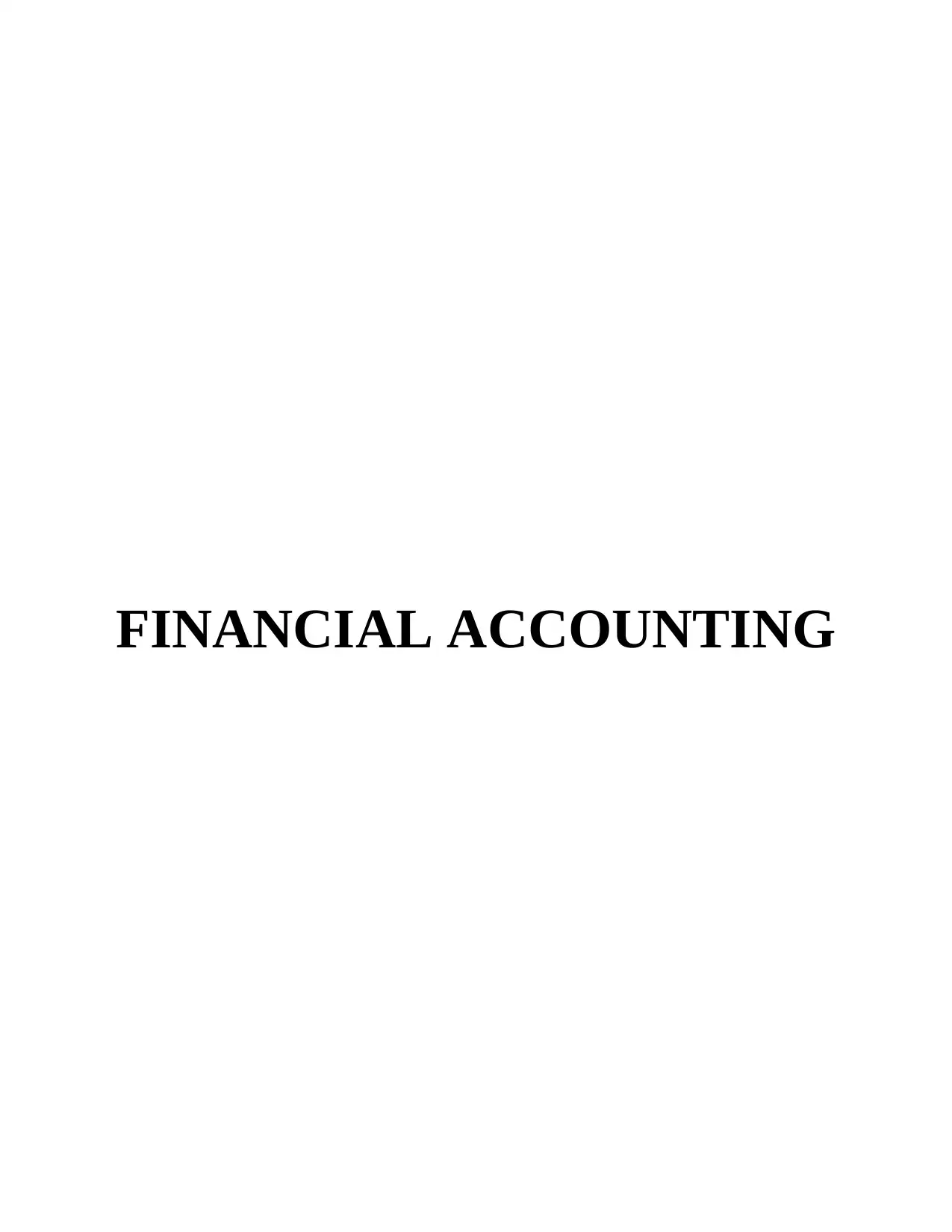
FINANCIAL ACCOUNTING
Paraphrase This Document
Need a fresh take? Get an instant paraphrase of this document with our AI Paraphraser
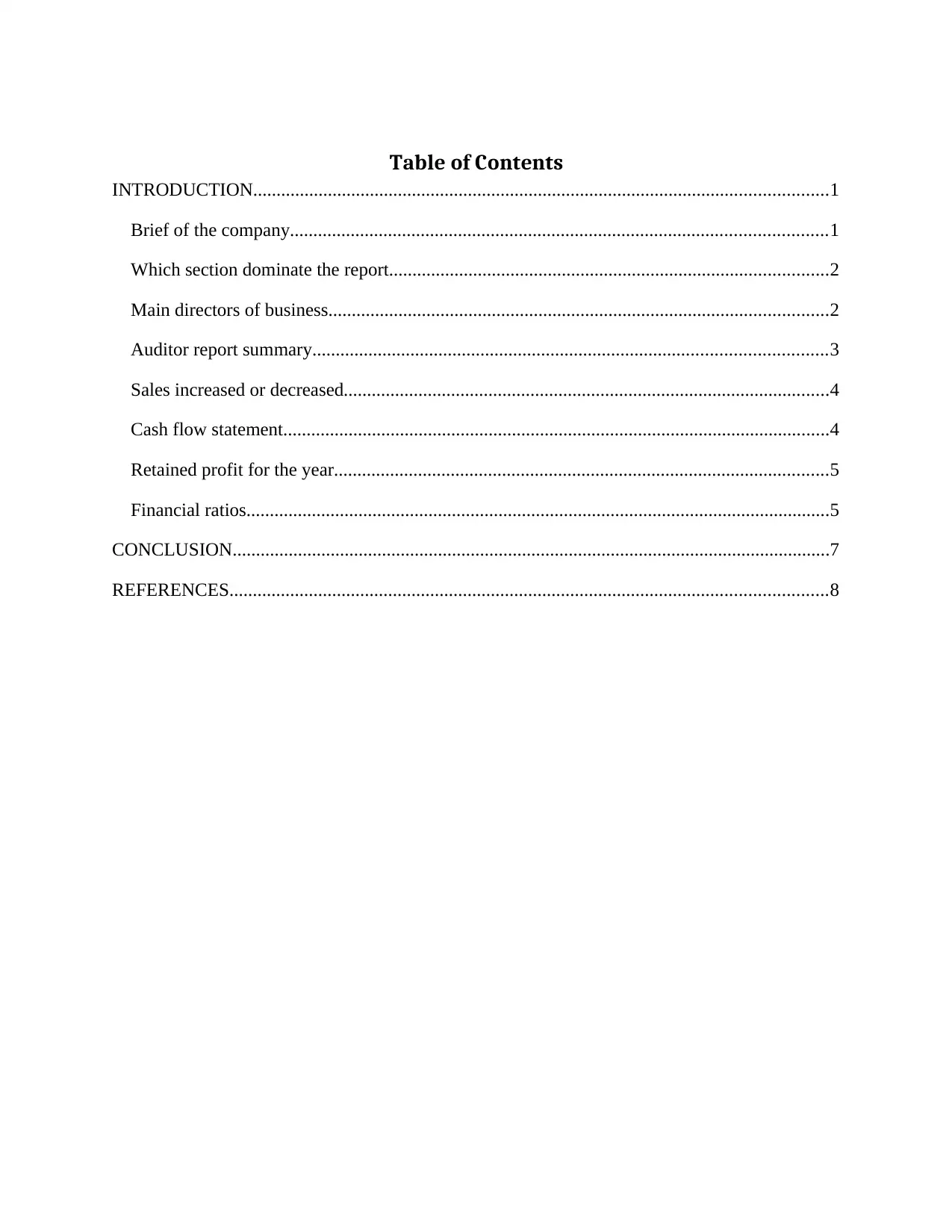
Table of Contents
INTRODUCTION...........................................................................................................................1
Brief of the company...................................................................................................................1
Which section dominate the report..............................................................................................2
Main directors of business...........................................................................................................2
Auditor report summary..............................................................................................................3
Sales increased or decreased........................................................................................................4
Cash flow statement.....................................................................................................................4
Retained profit for the year..........................................................................................................5
Financial ratios.............................................................................................................................5
CONCLUSION................................................................................................................................7
REFERENCES................................................................................................................................8
INTRODUCTION...........................................................................................................................1
Brief of the company...................................................................................................................1
Which section dominate the report..............................................................................................2
Main directors of business...........................................................................................................2
Auditor report summary..............................................................................................................3
Sales increased or decreased........................................................................................................4
Cash flow statement.....................................................................................................................4
Retained profit for the year..........................................................................................................5
Financial ratios.............................................................................................................................5
CONCLUSION................................................................................................................................7
REFERENCES................................................................................................................................8
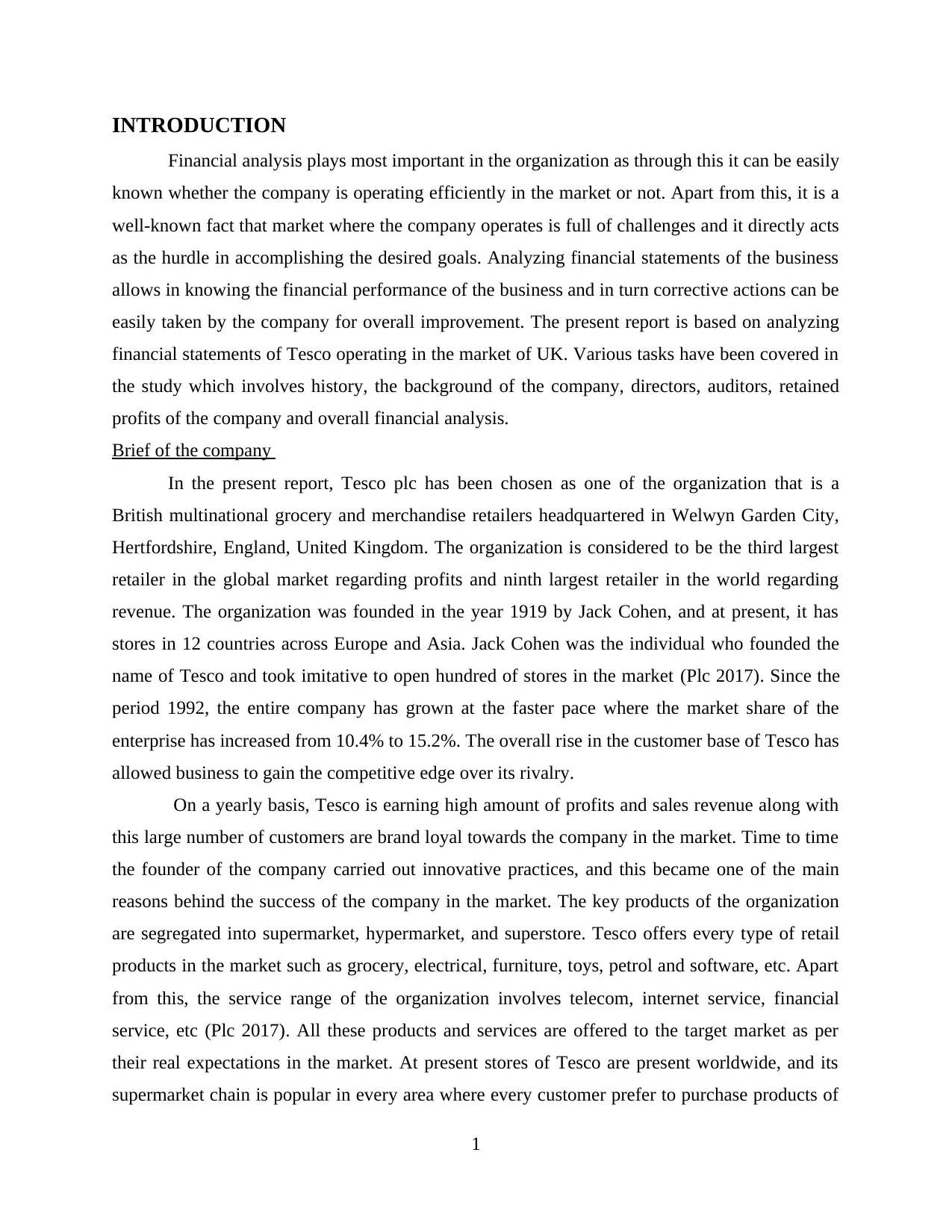
INTRODUCTION
Financial analysis plays most important in the organization as through this it can be easily
known whether the company is operating efficiently in the market or not. Apart from this, it is a
well-known fact that market where the company operates is full of challenges and it directly acts
as the hurdle in accomplishing the desired goals. Analyzing financial statements of the business
allows in knowing the financial performance of the business and in turn corrective actions can be
easily taken by the company for overall improvement. The present report is based on analyzing
financial statements of Tesco operating in the market of UK. Various tasks have been covered in
the study which involves history, the background of the company, directors, auditors, retained
profits of the company and overall financial analysis.
Brief of the company
In the present report, Tesco plc has been chosen as one of the organization that is a
British multinational grocery and merchandise retailers headquartered in Welwyn Garden City,
Hertfordshire, England, United Kingdom. The organization is considered to be the third largest
retailer in the global market regarding profits and ninth largest retailer in the world regarding
revenue. The organization was founded in the year 1919 by Jack Cohen, and at present, it has
stores in 12 countries across Europe and Asia. Jack Cohen was the individual who founded the
name of Tesco and took imitative to open hundred of stores in the market (Plc 2017). Since the
period 1992, the entire company has grown at the faster pace where the market share of the
enterprise has increased from 10.4% to 15.2%. The overall rise in the customer base of Tesco has
allowed business to gain the competitive edge over its rivalry.
On a yearly basis, Tesco is earning high amount of profits and sales revenue along with
this large number of customers are brand loyal towards the company in the market. Time to time
the founder of the company carried out innovative practices, and this became one of the main
reasons behind the success of the company in the market. The key products of the organization
are segregated into supermarket, hypermarket, and superstore. Tesco offers every type of retail
products in the market such as grocery, electrical, furniture, toys, petrol and software, etc. Apart
from this, the service range of the organization involves telecom, internet service, financial
service, etc (Plc 2017). All these products and services are offered to the target market as per
their real expectations in the market. At present stores of Tesco are present worldwide, and its
supermarket chain is popular in every area where every customer prefer to purchase products of
1
Financial analysis plays most important in the organization as through this it can be easily
known whether the company is operating efficiently in the market or not. Apart from this, it is a
well-known fact that market where the company operates is full of challenges and it directly acts
as the hurdle in accomplishing the desired goals. Analyzing financial statements of the business
allows in knowing the financial performance of the business and in turn corrective actions can be
easily taken by the company for overall improvement. The present report is based on analyzing
financial statements of Tesco operating in the market of UK. Various tasks have been covered in
the study which involves history, the background of the company, directors, auditors, retained
profits of the company and overall financial analysis.
Brief of the company
In the present report, Tesco plc has been chosen as one of the organization that is a
British multinational grocery and merchandise retailers headquartered in Welwyn Garden City,
Hertfordshire, England, United Kingdom. The organization is considered to be the third largest
retailer in the global market regarding profits and ninth largest retailer in the world regarding
revenue. The organization was founded in the year 1919 by Jack Cohen, and at present, it has
stores in 12 countries across Europe and Asia. Jack Cohen was the individual who founded the
name of Tesco and took imitative to open hundred of stores in the market (Plc 2017). Since the
period 1992, the entire company has grown at the faster pace where the market share of the
enterprise has increased from 10.4% to 15.2%. The overall rise in the customer base of Tesco has
allowed business to gain the competitive edge over its rivalry.
On a yearly basis, Tesco is earning high amount of profits and sales revenue along with
this large number of customers are brand loyal towards the company in the market. Time to time
the founder of the company carried out innovative practices, and this became one of the main
reasons behind the success of the company in the market. The key products of the organization
are segregated into supermarket, hypermarket, and superstore. Tesco offers every type of retail
products in the market such as grocery, electrical, furniture, toys, petrol and software, etc. Apart
from this, the service range of the organization involves telecom, internet service, financial
service, etc (Plc 2017). All these products and services are offered to the target market as per
their real expectations in the market. At present stores of Tesco are present worldwide, and its
supermarket chain is popular in every area where every customer prefer to purchase products of
1
⊘ This is a preview!⊘
Do you want full access?
Subscribe today to unlock all pages.

Trusted by 1+ million students worldwide
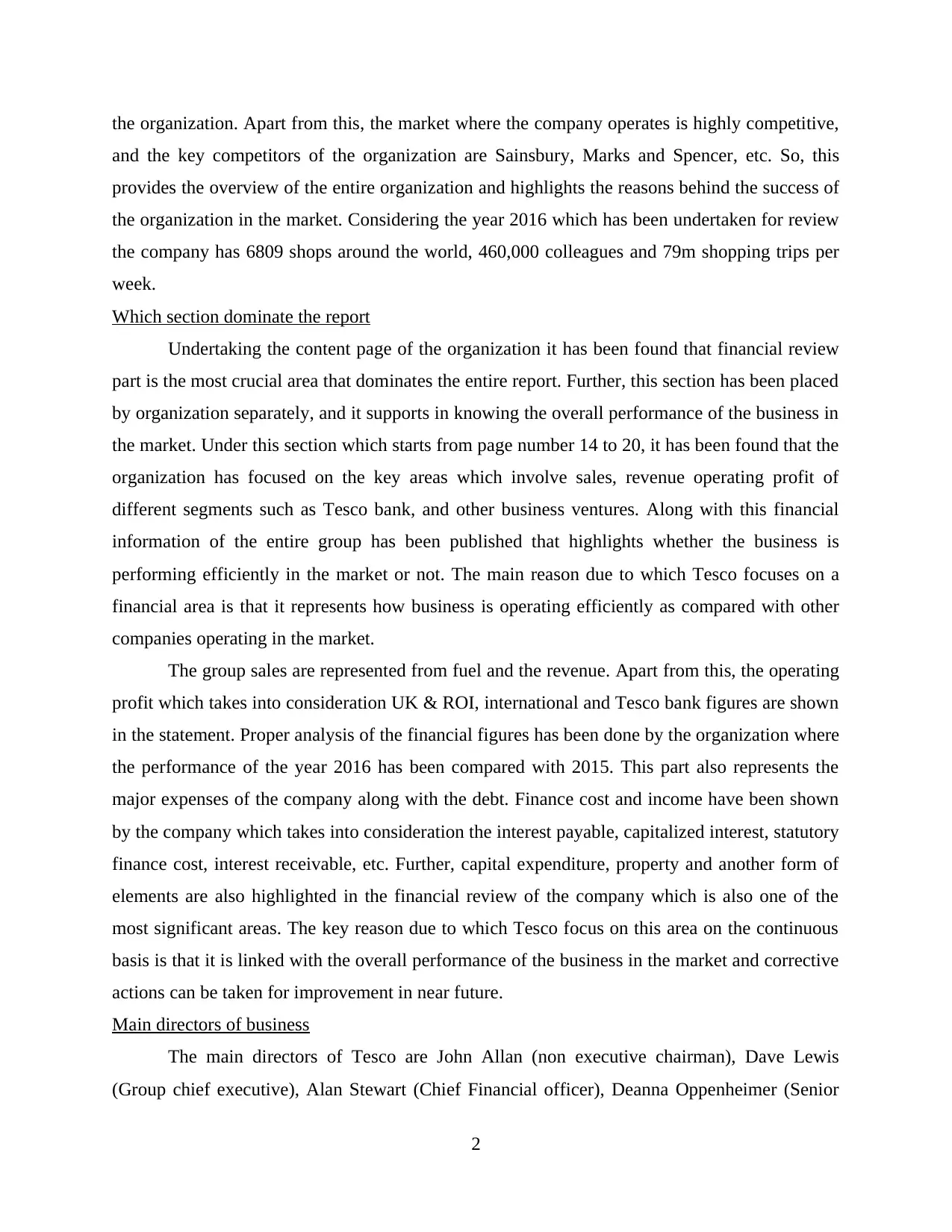
the organization. Apart from this, the market where the company operates is highly competitive,
and the key competitors of the organization are Sainsbury, Marks and Spencer, etc. So, this
provides the overview of the entire organization and highlights the reasons behind the success of
the organization in the market. Considering the year 2016 which has been undertaken for review
the company has 6809 shops around the world, 460,000 colleagues and 79m shopping trips per
week.
Which section dominate the report
Undertaking the content page of the organization it has been found that financial review
part is the most crucial area that dominates the entire report. Further, this section has been placed
by organization separately, and it supports in knowing the overall performance of the business in
the market. Under this section which starts from page number 14 to 20, it has been found that the
organization has focused on the key areas which involve sales, revenue operating profit of
different segments such as Tesco bank, and other business ventures. Along with this financial
information of the entire group has been published that highlights whether the business is
performing efficiently in the market or not. The main reason due to which Tesco focuses on a
financial area is that it represents how business is operating efficiently as compared with other
companies operating in the market.
The group sales are represented from fuel and the revenue. Apart from this, the operating
profit which takes into consideration UK & ROI, international and Tesco bank figures are shown
in the statement. Proper analysis of the financial figures has been done by the organization where
the performance of the year 2016 has been compared with 2015. This part also represents the
major expenses of the company along with the debt. Finance cost and income have been shown
by the company which takes into consideration the interest payable, capitalized interest, statutory
finance cost, interest receivable, etc. Further, capital expenditure, property and another form of
elements are also highlighted in the financial review of the company which is also one of the
most significant areas. The key reason due to which Tesco focus on this area on the continuous
basis is that it is linked with the overall performance of the business in the market and corrective
actions can be taken for improvement in near future.
Main directors of business
The main directors of Tesco are John Allan (non executive chairman), Dave Lewis
(Group chief executive), Alan Stewart (Chief Financial officer), Deanna Oppenheimer (Senior
2
and the key competitors of the organization are Sainsbury, Marks and Spencer, etc. So, this
provides the overview of the entire organization and highlights the reasons behind the success of
the organization in the market. Considering the year 2016 which has been undertaken for review
the company has 6809 shops around the world, 460,000 colleagues and 79m shopping trips per
week.
Which section dominate the report
Undertaking the content page of the organization it has been found that financial review
part is the most crucial area that dominates the entire report. Further, this section has been placed
by organization separately, and it supports in knowing the overall performance of the business in
the market. Under this section which starts from page number 14 to 20, it has been found that the
organization has focused on the key areas which involve sales, revenue operating profit of
different segments such as Tesco bank, and other business ventures. Along with this financial
information of the entire group has been published that highlights whether the business is
performing efficiently in the market or not. The main reason due to which Tesco focuses on a
financial area is that it represents how business is operating efficiently as compared with other
companies operating in the market.
The group sales are represented from fuel and the revenue. Apart from this, the operating
profit which takes into consideration UK & ROI, international and Tesco bank figures are shown
in the statement. Proper analysis of the financial figures has been done by the organization where
the performance of the year 2016 has been compared with 2015. This part also represents the
major expenses of the company along with the debt. Finance cost and income have been shown
by the company which takes into consideration the interest payable, capitalized interest, statutory
finance cost, interest receivable, etc. Further, capital expenditure, property and another form of
elements are also highlighted in the financial review of the company which is also one of the
most significant areas. The key reason due to which Tesco focus on this area on the continuous
basis is that it is linked with the overall performance of the business in the market and corrective
actions can be taken for improvement in near future.
Main directors of business
The main directors of Tesco are John Allan (non executive chairman), Dave Lewis
(Group chief executive), Alan Stewart (Chief Financial officer), Deanna Oppenheimer (Senior
2
Paraphrase This Document
Need a fresh take? Get an instant paraphrase of this document with our AI Paraphraser
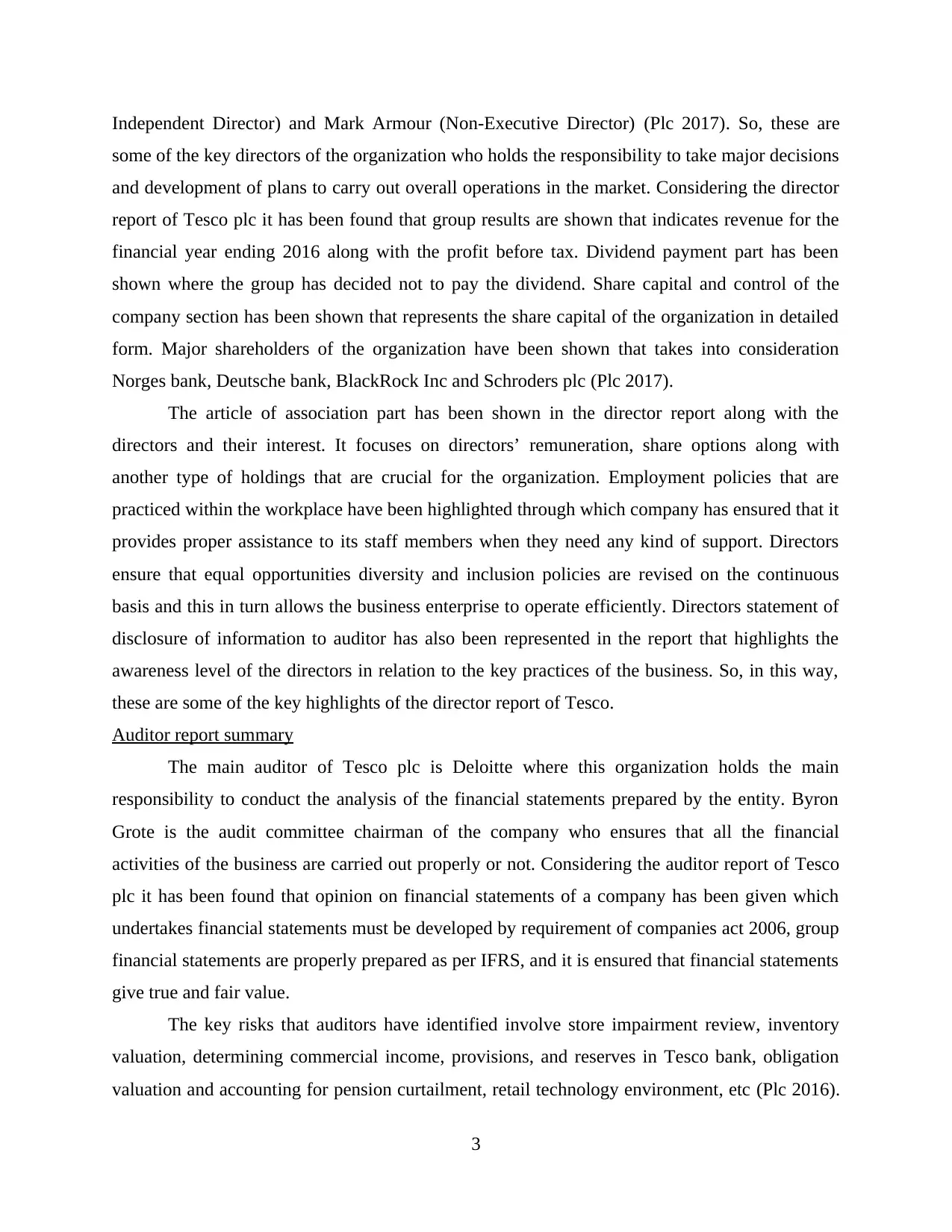
Independent Director) and Mark Armour (Non-Executive Director) (Plc 2017). So, these are
some of the key directors of the organization who holds the responsibility to take major decisions
and development of plans to carry out overall operations in the market. Considering the director
report of Tesco plc it has been found that group results are shown that indicates revenue for the
financial year ending 2016 along with the profit before tax. Dividend payment part has been
shown where the group has decided not to pay the dividend. Share capital and control of the
company section has been shown that represents the share capital of the organization in detailed
form. Major shareholders of the organization have been shown that takes into consideration
Norges bank, Deutsche bank, BlackRock Inc and Schroders plc (Plc 2017).
The article of association part has been shown in the director report along with the
directors and their interest. It focuses on directors’ remuneration, share options along with
another type of holdings that are crucial for the organization. Employment policies that are
practiced within the workplace have been highlighted through which company has ensured that it
provides proper assistance to its staff members when they need any kind of support. Directors
ensure that equal opportunities diversity and inclusion policies are revised on the continuous
basis and this in turn allows the business enterprise to operate efficiently. Directors statement of
disclosure of information to auditor has also been represented in the report that highlights the
awareness level of the directors in relation to the key practices of the business. So, in this way,
these are some of the key highlights of the director report of Tesco.
Auditor report summary
The main auditor of Tesco plc is Deloitte where this organization holds the main
responsibility to conduct the analysis of the financial statements prepared by the entity. Byron
Grote is the audit committee chairman of the company who ensures that all the financial
activities of the business are carried out properly or not. Considering the auditor report of Tesco
plc it has been found that opinion on financial statements of a company has been given which
undertakes financial statements must be developed by requirement of companies act 2006, group
financial statements are properly prepared as per IFRS, and it is ensured that financial statements
give true and fair value.
The key risks that auditors have identified involve store impairment review, inventory
valuation, determining commercial income, provisions, and reserves in Tesco bank, obligation
valuation and accounting for pension curtailment, retail technology environment, etc (Plc 2016).
3
some of the key directors of the organization who holds the responsibility to take major decisions
and development of plans to carry out overall operations in the market. Considering the director
report of Tesco plc it has been found that group results are shown that indicates revenue for the
financial year ending 2016 along with the profit before tax. Dividend payment part has been
shown where the group has decided not to pay the dividend. Share capital and control of the
company section has been shown that represents the share capital of the organization in detailed
form. Major shareholders of the organization have been shown that takes into consideration
Norges bank, Deutsche bank, BlackRock Inc and Schroders plc (Plc 2017).
The article of association part has been shown in the director report along with the
directors and their interest. It focuses on directors’ remuneration, share options along with
another type of holdings that are crucial for the organization. Employment policies that are
practiced within the workplace have been highlighted through which company has ensured that it
provides proper assistance to its staff members when they need any kind of support. Directors
ensure that equal opportunities diversity and inclusion policies are revised on the continuous
basis and this in turn allows the business enterprise to operate efficiently. Directors statement of
disclosure of information to auditor has also been represented in the report that highlights the
awareness level of the directors in relation to the key practices of the business. So, in this way,
these are some of the key highlights of the director report of Tesco.
Auditor report summary
The main auditor of Tesco plc is Deloitte where this organization holds the main
responsibility to conduct the analysis of the financial statements prepared by the entity. Byron
Grote is the audit committee chairman of the company who ensures that all the financial
activities of the business are carried out properly or not. Considering the auditor report of Tesco
plc it has been found that opinion on financial statements of a company has been given which
undertakes financial statements must be developed by requirement of companies act 2006, group
financial statements are properly prepared as per IFRS, and it is ensured that financial statements
give true and fair value.
The key risks that auditors have identified involve store impairment review, inventory
valuation, determining commercial income, provisions, and reserves in Tesco bank, obligation
valuation and accounting for pension curtailment, retail technology environment, etc (Plc 2016).
3
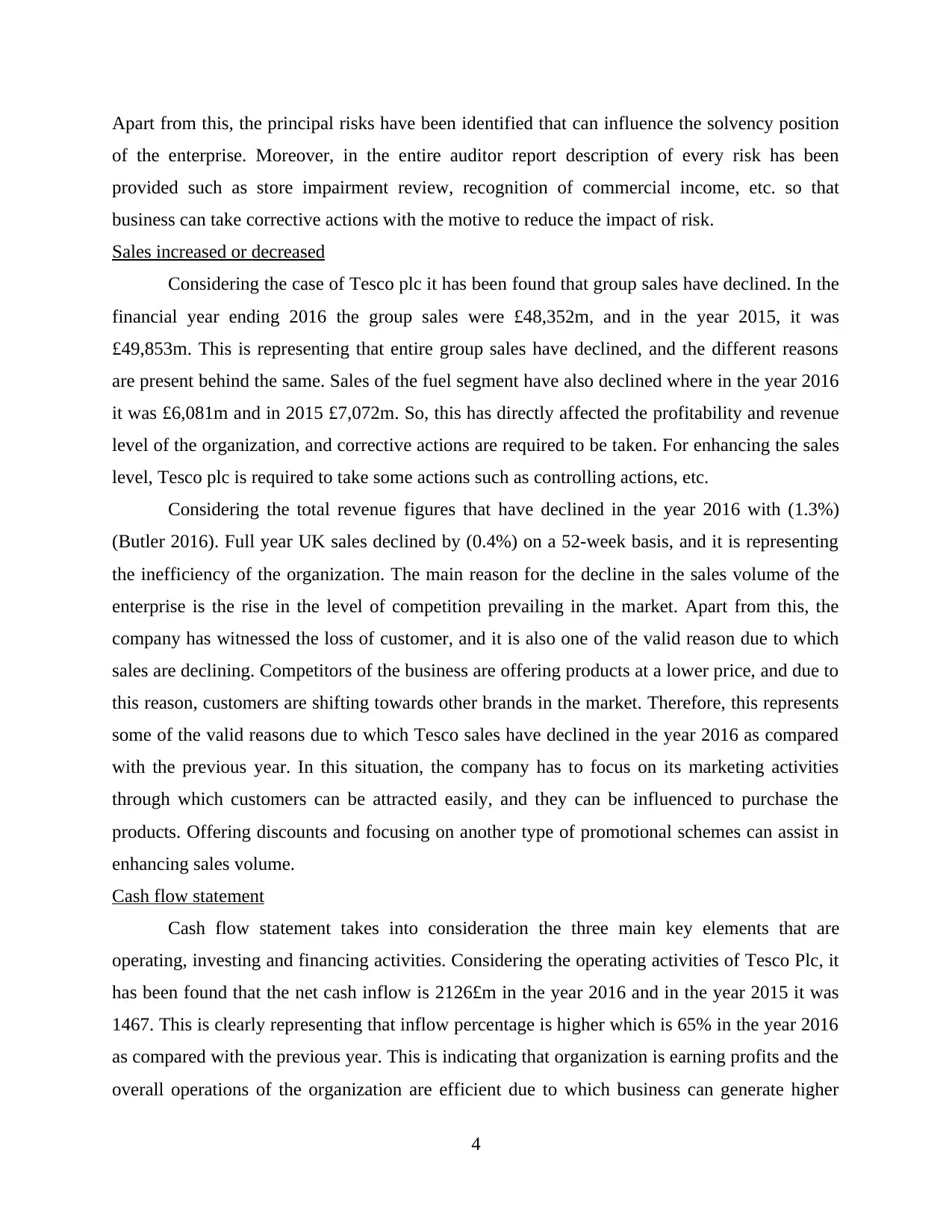
Apart from this, the principal risks have been identified that can influence the solvency position
of the enterprise. Moreover, in the entire auditor report description of every risk has been
provided such as store impairment review, recognition of commercial income, etc. so that
business can take corrective actions with the motive to reduce the impact of risk.
Sales increased or decreased
Considering the case of Tesco plc it has been found that group sales have declined. In the
financial year ending 2016 the group sales were £48,352m, and in the year 2015, it was
£49,853m. This is representing that entire group sales have declined, and the different reasons
are present behind the same. Sales of the fuel segment have also declined where in the year 2016
it was £6,081m and in 2015 £7,072m. So, this has directly affected the profitability and revenue
level of the organization, and corrective actions are required to be taken. For enhancing the sales
level, Tesco plc is required to take some actions such as controlling actions, etc.
Considering the total revenue figures that have declined in the year 2016 with (1.3%)
(Butler 2016). Full year UK sales declined by (0.4%) on a 52-week basis, and it is representing
the inefficiency of the organization. The main reason for the decline in the sales volume of the
enterprise is the rise in the level of competition prevailing in the market. Apart from this, the
company has witnessed the loss of customer, and it is also one of the valid reason due to which
sales are declining. Competitors of the business are offering products at a lower price, and due to
this reason, customers are shifting towards other brands in the market. Therefore, this represents
some of the valid reasons due to which Tesco sales have declined in the year 2016 as compared
with the previous year. In this situation, the company has to focus on its marketing activities
through which customers can be attracted easily, and they can be influenced to purchase the
products. Offering discounts and focusing on another type of promotional schemes can assist in
enhancing sales volume.
Cash flow statement
Cash flow statement takes into consideration the three main key elements that are
operating, investing and financing activities. Considering the operating activities of Tesco Plc, it
has been found that the net cash inflow is 2126£m in the year 2016 and in the year 2015 it was
1467. This is clearly representing that inflow percentage is higher which is 65% in the year 2016
as compared with the previous year. This is indicating that organization is earning profits and the
overall operations of the organization are efficient due to which business can generate higher
4
of the enterprise. Moreover, in the entire auditor report description of every risk has been
provided such as store impairment review, recognition of commercial income, etc. so that
business can take corrective actions with the motive to reduce the impact of risk.
Sales increased or decreased
Considering the case of Tesco plc it has been found that group sales have declined. In the
financial year ending 2016 the group sales were £48,352m, and in the year 2015, it was
£49,853m. This is representing that entire group sales have declined, and the different reasons
are present behind the same. Sales of the fuel segment have also declined where in the year 2016
it was £6,081m and in 2015 £7,072m. So, this has directly affected the profitability and revenue
level of the organization, and corrective actions are required to be taken. For enhancing the sales
level, Tesco plc is required to take some actions such as controlling actions, etc.
Considering the total revenue figures that have declined in the year 2016 with (1.3%)
(Butler 2016). Full year UK sales declined by (0.4%) on a 52-week basis, and it is representing
the inefficiency of the organization. The main reason for the decline in the sales volume of the
enterprise is the rise in the level of competition prevailing in the market. Apart from this, the
company has witnessed the loss of customer, and it is also one of the valid reason due to which
sales are declining. Competitors of the business are offering products at a lower price, and due to
this reason, customers are shifting towards other brands in the market. Therefore, this represents
some of the valid reasons due to which Tesco sales have declined in the year 2016 as compared
with the previous year. In this situation, the company has to focus on its marketing activities
through which customers can be attracted easily, and they can be influenced to purchase the
products. Offering discounts and focusing on another type of promotional schemes can assist in
enhancing sales volume.
Cash flow statement
Cash flow statement takes into consideration the three main key elements that are
operating, investing and financing activities. Considering the operating activities of Tesco Plc, it
has been found that the net cash inflow is 2126£m in the year 2016 and in the year 2015 it was
1467. This is clearly representing that inflow percentage is higher which is 65% in the year 2016
as compared with the previous year. This is indicating that organization is earning profits and the
overall operations of the organization are efficient due to which business can generate higher
4
⊘ This is a preview!⊘
Do you want full access?
Subscribe today to unlock all pages.

Trusted by 1+ million students worldwide
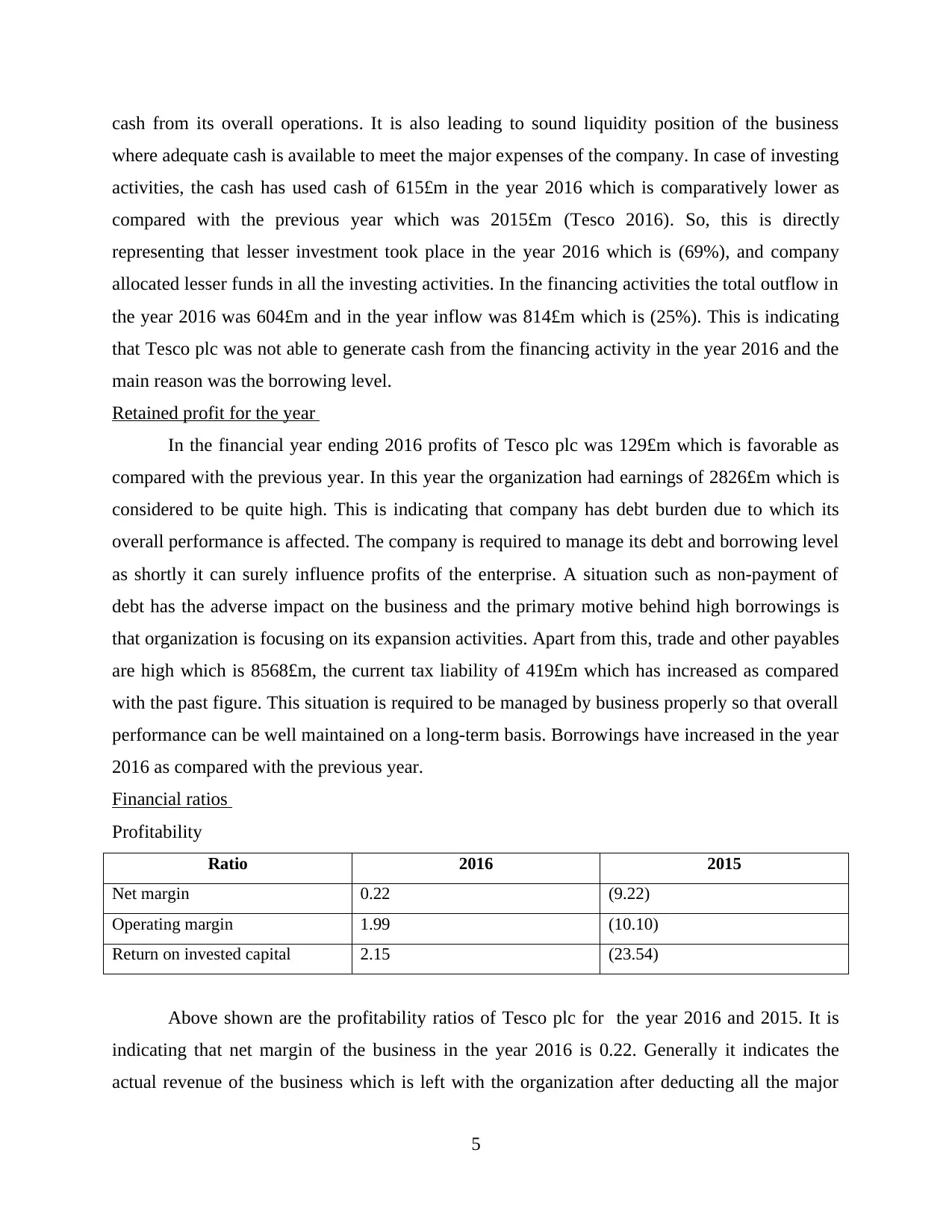
cash from its overall operations. It is also leading to sound liquidity position of the business
where adequate cash is available to meet the major expenses of the company. In case of investing
activities, the cash has used cash of 615£m in the year 2016 which is comparatively lower as
compared with the previous year which was 2015£m (Tesco 2016). So, this is directly
representing that lesser investment took place in the year 2016 which is (69%), and company
allocated lesser funds in all the investing activities. In the financing activities the total outflow in
the year 2016 was 604£m and in the year inflow was 814£m which is (25%). This is indicating
that Tesco plc was not able to generate cash from the financing activity in the year 2016 and the
main reason was the borrowing level.
Retained profit for the year
In the financial year ending 2016 profits of Tesco plc was 129£m which is favorable as
compared with the previous year. In this year the organization had earnings of 2826£m which is
considered to be quite high. This is indicating that company has debt burden due to which its
overall performance is affected. The company is required to manage its debt and borrowing level
as shortly it can surely influence profits of the enterprise. A situation such as non-payment of
debt has the adverse impact on the business and the primary motive behind high borrowings is
that organization is focusing on its expansion activities. Apart from this, trade and other payables
are high which is 8568£m, the current tax liability of 419£m which has increased as compared
with the past figure. This situation is required to be managed by business properly so that overall
performance can be well maintained on a long-term basis. Borrowings have increased in the year
2016 as compared with the previous year.
Financial ratios
Profitability
Ratio 2016 2015
Net margin 0.22 (9.22)
Operating margin 1.99 (10.10)
Return on invested capital 2.15 (23.54)
Above shown are the profitability ratios of Tesco plc for the year 2016 and 2015. It is
indicating that net margin of the business in the year 2016 is 0.22. Generally it indicates the
actual revenue of the business which is left with the organization after deducting all the major
5
where adequate cash is available to meet the major expenses of the company. In case of investing
activities, the cash has used cash of 615£m in the year 2016 which is comparatively lower as
compared with the previous year which was 2015£m (Tesco 2016). So, this is directly
representing that lesser investment took place in the year 2016 which is (69%), and company
allocated lesser funds in all the investing activities. In the financing activities the total outflow in
the year 2016 was 604£m and in the year inflow was 814£m which is (25%). This is indicating
that Tesco plc was not able to generate cash from the financing activity in the year 2016 and the
main reason was the borrowing level.
Retained profit for the year
In the financial year ending 2016 profits of Tesco plc was 129£m which is favorable as
compared with the previous year. In this year the organization had earnings of 2826£m which is
considered to be quite high. This is indicating that company has debt burden due to which its
overall performance is affected. The company is required to manage its debt and borrowing level
as shortly it can surely influence profits of the enterprise. A situation such as non-payment of
debt has the adverse impact on the business and the primary motive behind high borrowings is
that organization is focusing on its expansion activities. Apart from this, trade and other payables
are high which is 8568£m, the current tax liability of 419£m which has increased as compared
with the past figure. This situation is required to be managed by business properly so that overall
performance can be well maintained on a long-term basis. Borrowings have increased in the year
2016 as compared with the previous year.
Financial ratios
Profitability
Ratio 2016 2015
Net margin 0.22 (9.22)
Operating margin 1.99 (10.10)
Return on invested capital 2.15 (23.54)
Above shown are the profitability ratios of Tesco plc for the year 2016 and 2015. It is
indicating that net margin of the business in the year 2016 is 0.22. Generally it indicates the
actual revenue of the business which is left with the organization after deducting all the major
5
Paraphrase This Document
Need a fresh take? Get an instant paraphrase of this document with our AI Paraphraser
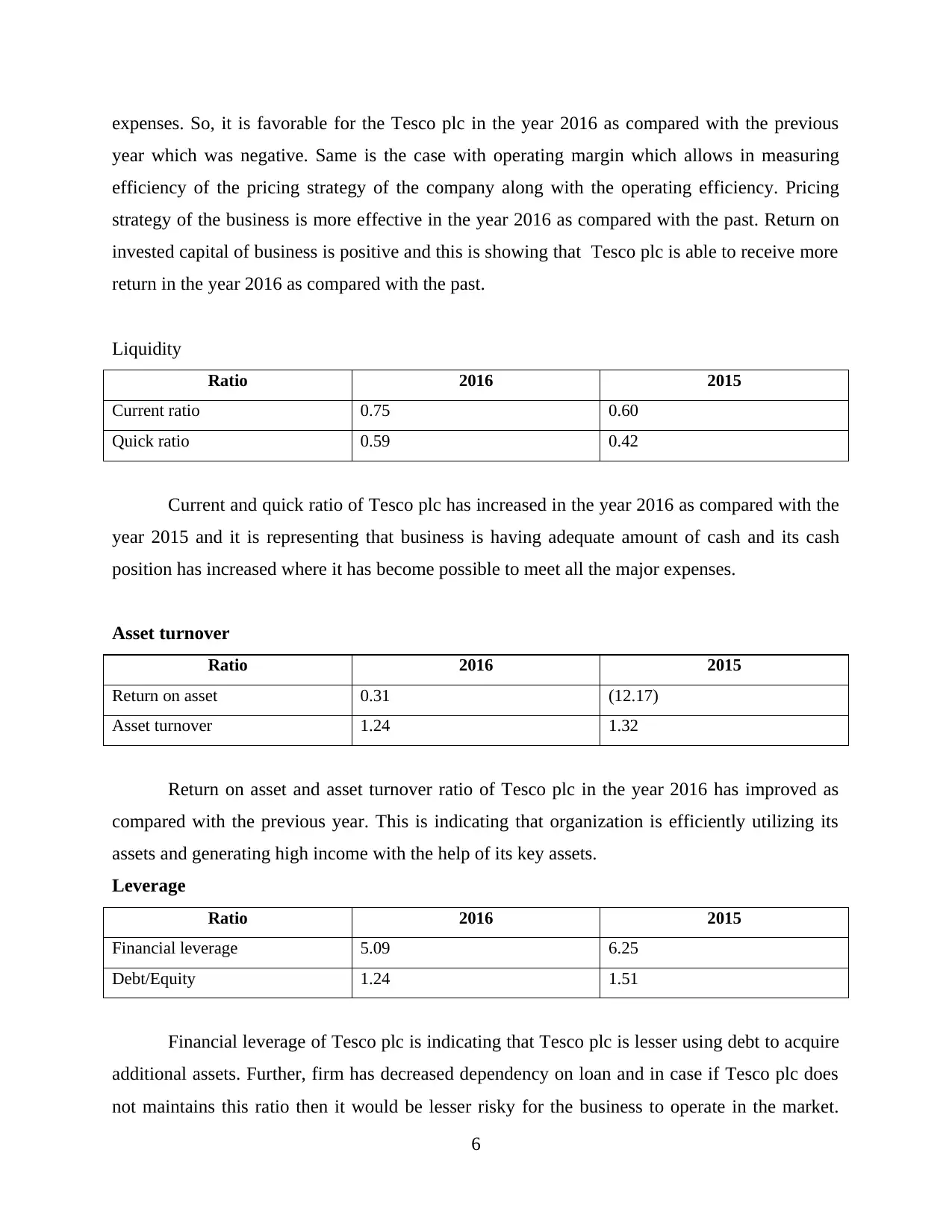
expenses. So, it is favorable for the Tesco plc in the year 2016 as compared with the previous
year which was negative. Same is the case with operating margin which allows in measuring
efficiency of the pricing strategy of the company along with the operating efficiency. Pricing
strategy of the business is more effective in the year 2016 as compared with the past. Return on
invested capital of business is positive and this is showing that Tesco plc is able to receive more
return in the year 2016 as compared with the past.
Liquidity
Ratio 2016 2015
Current ratio 0.75 0.60
Quick ratio 0.59 0.42
Current and quick ratio of Tesco plc has increased in the year 2016 as compared with the
year 2015 and it is representing that business is having adequate amount of cash and its cash
position has increased where it has become possible to meet all the major expenses.
Asset turnover
Ratio 2016 2015
Return on asset 0.31 (12.17)
Asset turnover 1.24 1.32
Return on asset and asset turnover ratio of Tesco plc in the year 2016 has improved as
compared with the previous year. This is indicating that organization is efficiently utilizing its
assets and generating high income with the help of its key assets.
Leverage
Ratio 2016 2015
Financial leverage 5.09 6.25
Debt/Equity 1.24 1.51
Financial leverage of Tesco plc is indicating that Tesco plc is lesser using debt to acquire
additional assets. Further, firm has decreased dependency on loan and in case if Tesco plc does
not maintains this ratio then it would be lesser risky for the business to operate in the market.
6
year which was negative. Same is the case with operating margin which allows in measuring
efficiency of the pricing strategy of the company along with the operating efficiency. Pricing
strategy of the business is more effective in the year 2016 as compared with the past. Return on
invested capital of business is positive and this is showing that Tesco plc is able to receive more
return in the year 2016 as compared with the past.
Liquidity
Ratio 2016 2015
Current ratio 0.75 0.60
Quick ratio 0.59 0.42
Current and quick ratio of Tesco plc has increased in the year 2016 as compared with the
year 2015 and it is representing that business is having adequate amount of cash and its cash
position has increased where it has become possible to meet all the major expenses.
Asset turnover
Ratio 2016 2015
Return on asset 0.31 (12.17)
Asset turnover 1.24 1.32
Return on asset and asset turnover ratio of Tesco plc in the year 2016 has improved as
compared with the previous year. This is indicating that organization is efficiently utilizing its
assets and generating high income with the help of its key assets.
Leverage
Ratio 2016 2015
Financial leverage 5.09 6.25
Debt/Equity 1.24 1.51
Financial leverage of Tesco plc is indicating that Tesco plc is lesser using debt to acquire
additional assets. Further, firm has decreased dependency on loan and in case if Tesco plc does
not maintains this ratio then it would be lesser risky for the business to operate in the market.
6
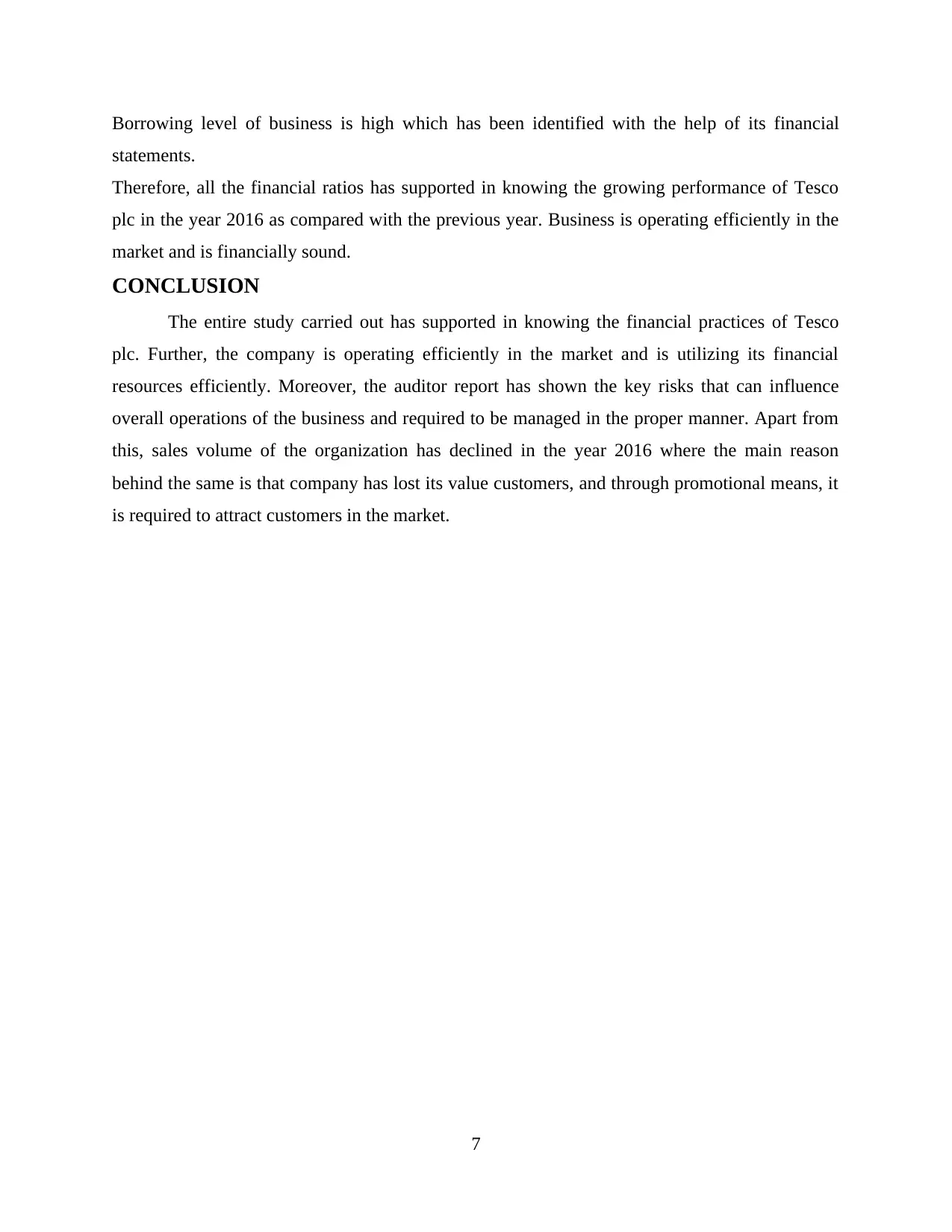
Borrowing level of business is high which has been identified with the help of its financial
statements.
Therefore, all the financial ratios has supported in knowing the growing performance of Tesco
plc in the year 2016 as compared with the previous year. Business is operating efficiently in the
market and is financially sound.
CONCLUSION
The entire study carried out has supported in knowing the financial practices of Tesco
plc. Further, the company is operating efficiently in the market and is utilizing its financial
resources efficiently. Moreover, the auditor report has shown the key risks that can influence
overall operations of the business and required to be managed in the proper manner. Apart from
this, sales volume of the organization has declined in the year 2016 where the main reason
behind the same is that company has lost its value customers, and through promotional means, it
is required to attract customers in the market.
7
statements.
Therefore, all the financial ratios has supported in knowing the growing performance of Tesco
plc in the year 2016 as compared with the previous year. Business is operating efficiently in the
market and is financially sound.
CONCLUSION
The entire study carried out has supported in knowing the financial practices of Tesco
plc. Further, the company is operating efficiently in the market and is utilizing its financial
resources efficiently. Moreover, the auditor report has shown the key risks that can influence
overall operations of the business and required to be managed in the proper manner. Apart from
this, sales volume of the organization has declined in the year 2016 where the main reason
behind the same is that company has lost its value customers, and through promotional means, it
is required to attract customers in the market.
7
⊘ This is a preview!⊘
Do you want full access?
Subscribe today to unlock all pages.

Trusted by 1+ million students worldwide
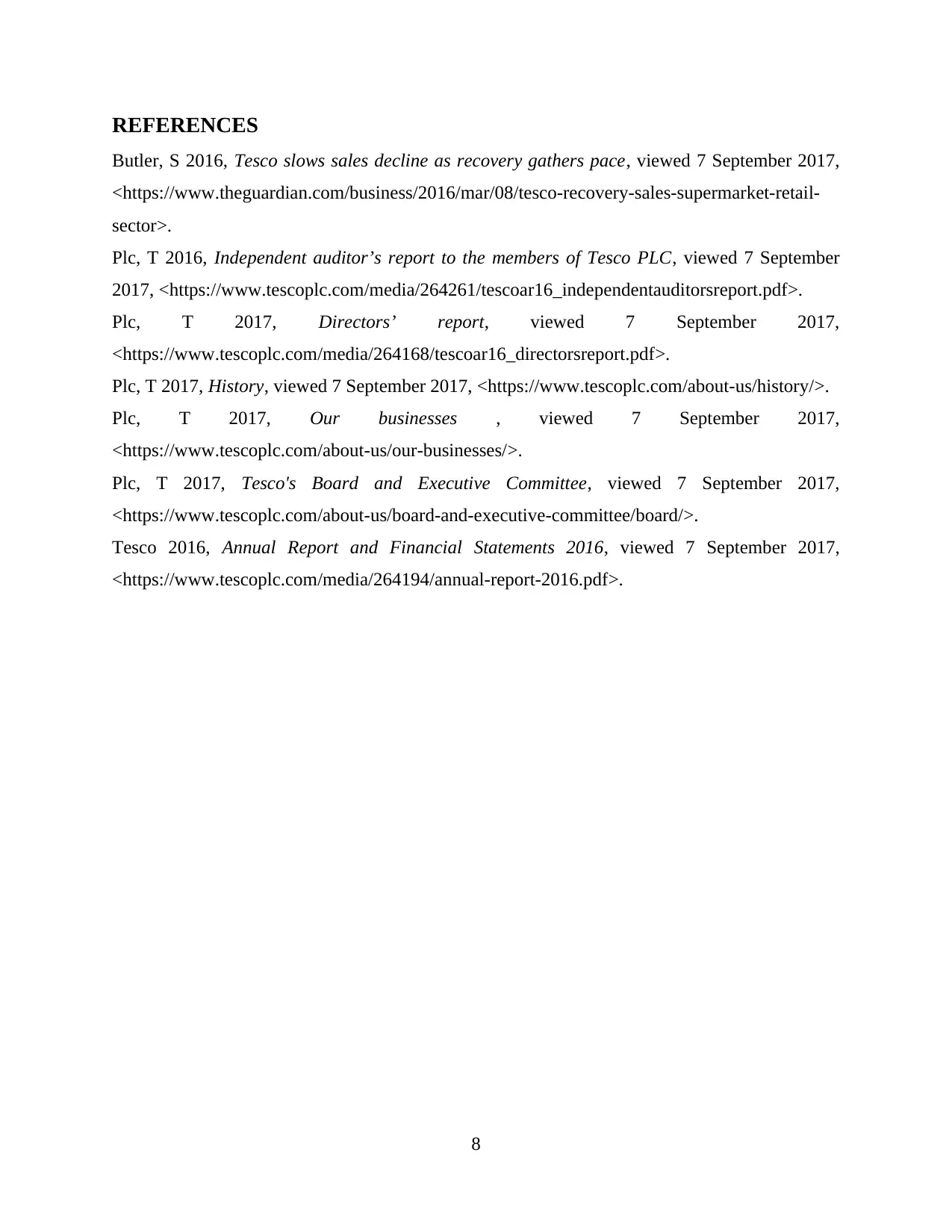
REFERENCES
Butler, S 2016, Tesco slows sales decline as recovery gathers pace, viewed 7 September 2017,
<https://www.theguardian.com/business/2016/mar/08/tesco-recovery-sales-supermarket-retail-
sector>.
Plc, T 2016, Independent auditor’s report to the members of Tesco PLC, viewed 7 September
2017, <https://www.tescoplc.com/media/264261/tescoar16_independentauditorsreport.pdf>.
Plc, T 2017, Directors’ report, viewed 7 September 2017,
<https://www.tescoplc.com/media/264168/tescoar16_directorsreport.pdf>.
Plc, T 2017, History, viewed 7 September 2017, <https://www.tescoplc.com/about-us/history/>.
Plc, T 2017, Our businesses , viewed 7 September 2017,
<https://www.tescoplc.com/about-us/our-businesses/>.
Plc, T 2017, Tesco's Board and Executive Committee, viewed 7 September 2017,
<https://www.tescoplc.com/about-us/board-and-executive-committee/board/>.
Tesco 2016, Annual Report and Financial Statements 2016, viewed 7 September 2017,
<https://www.tescoplc.com/media/264194/annual-report-2016.pdf>.
8
Butler, S 2016, Tesco slows sales decline as recovery gathers pace, viewed 7 September 2017,
<https://www.theguardian.com/business/2016/mar/08/tesco-recovery-sales-supermarket-retail-
sector>.
Plc, T 2016, Independent auditor’s report to the members of Tesco PLC, viewed 7 September
2017, <https://www.tescoplc.com/media/264261/tescoar16_independentauditorsreport.pdf>.
Plc, T 2017, Directors’ report, viewed 7 September 2017,
<https://www.tescoplc.com/media/264168/tescoar16_directorsreport.pdf>.
Plc, T 2017, History, viewed 7 September 2017, <https://www.tescoplc.com/about-us/history/>.
Plc, T 2017, Our businesses , viewed 7 September 2017,
<https://www.tescoplc.com/about-us/our-businesses/>.
Plc, T 2017, Tesco's Board and Executive Committee, viewed 7 September 2017,
<https://www.tescoplc.com/about-us/board-and-executive-committee/board/>.
Tesco 2016, Annual Report and Financial Statements 2016, viewed 7 September 2017,
<https://www.tescoplc.com/media/264194/annual-report-2016.pdf>.
8
1 out of 10
Related Documents
Your All-in-One AI-Powered Toolkit for Academic Success.
+13062052269
info@desklib.com
Available 24*7 on WhatsApp / Email
![[object Object]](/_next/static/media/star-bottom.7253800d.svg)
Unlock your academic potential
Copyright © 2020–2025 A2Z Services. All Rights Reserved. Developed and managed by ZUCOL.





